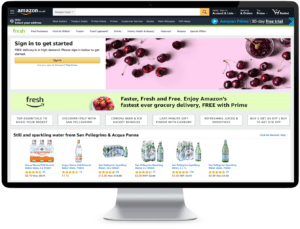The last few weeks have seen online grocery hit the headlines again and again. The expansion of Amazon Fresh to Prime members has added a new player to the UK’s online shopping ecosystem, Tesco responded with its free delivery announcement and now Morrisons is creating its own Amazon store.

Amazon is focusing a lot of attention on the grocery sector, which means that Sainsbury’s, Ocado and the rest are looking to react. The best way is to leverage what makes them special, especially if they want to avoid losing market share at a time when margins are tight and some ecommerce operations may currently make a loss.
So what can they do?
- Promote their supply chain credentials and best-practice products
- Focus on the exclusive ranges that won’t be available on Amazon, including own-brand
- Upweight their omnichannel credentials
- Reward existing shopper bases through widely-used loyalty programmes
- Offer unique, high-demand products
- Partnerships built on online logistical know-how
- Extend their range to include household items and clothing
- Leverage their technology platforms
- Use their customer service expertise
1. Promote their supply chain credentials and best-practice products
Supply chains matter when it comes to food. M&S’s field to fork sustainable farming standards are an example of leveraging that fact. There is a strong argument that knowing exactly where your food is coming from is more important than knowing where your webcams, books and umbrellas were made.


2. Focus on the exclusive ranges that won’t be available on Amazon, including own-brand
Supermarkets have invested huge amounts of money in their own-label ranges, such as Tesco Finest and Sainsbury’s Taste the Difference. More importantly, they have built up loyal customers who trust those products and see them as good value.
Further development and focus on these ranges will help to maintain loyal customers and sustain a valuable point of difference. There’s a lot of equity built up over the years that is worth capitalising on, at a time when Amazon doesn’t have own-brand food and drink in its portfolio.
3. Upweight their omnichannel credentials
UK supermarkets can offer physical stores, click and collect services and home delivery, which allow customers the opportunity to shop how they like, where they like and when they like. This will be hugely important if and when the world returns to normal.
Retailers should also better leverage the unique attributes of these different touchpoints and upweight the areas Amazon cannot offer at present: for example, the experiential opportunities their store footprints provide for cooking demos, product sampling and so on.
In addition, the incumbents’ own online capabilities will have improved dramatically over the past six months due to the lockdown. This presumably has already led to more loyal customers across their platforms, not least because people couldn’t get slots at other retailers and may be concerned that switching now will make it harder to get slots in future, if there was a second lockdown.
On the flip side, of course, familiarity with online grocery shopping may also mean shoppers are open to trying other brands.
4. Reward existing shopper bases through widely-used loyalty programmes
The likes of Tesco Clubcard and Sainsbury’s Nectar Card, rewarding customers for every shop, will be key as supermarkets look to reinforce their online offerings. This is not so much because of the ‘loyalty’ effect, as most customers carry more than one loyalty card, but more because of the data and insight they provide.
This is an advantage that the large grocery retailers have over Amazon, whose customer insight is well-known but has until now been limited on the grocery side. For example, geographical data will not only help to build relevant offers, but will also drive distribution centre efficiency through regional ranges. Stores in Yorkshire or Norfolk can offer local foods from local suppliers.
In fact, they could become more of a marketplace for hyper-local artisan manufacturers, in the way that Amazon has created a marketplace for small retailers.
5. Offer unique, high-demand products
Aldi has successfully mastered this with hero products in the ‘aisle of dreams’ or ‘aisle of impulse’ in the centre of its stores: good value spec items that are often seasonal. Supermarkets could add this type of innovative product offer to their online services.
In fact, potentially the incumbents could double-down on selling meal solutions and leave the ingredient selling to Amazon. They could leverage their wealth of data on individual shopping habits and use it to recommend scratch or ready-to-cook meal plans as part of the shop.
Equally, prepared foods and hot food may be a growth opportunity. Supermarkets could leverage their kitchen facilities to deliver ready-to-eat food as part of the shop, capitalising on their in-store delis or potentially providing dark kitchens.
6. Partnerships built on online logistical know-how
Some retailers have already seen which way the wind was blowing and created partnerships or joint ventures with established brands that have nailed the logistics ‘last mile’: Uber Eats, Deliveroo and Just Eat. Examples include M&S Food’s partnership with Ocado, Asda with Uber Eats and now Waitrose with Deliveroo.
This enables them to provide a competitive same-day delivery service, or even an immediate, within an hour or two delivery service for last minute / distressed purchases.
7. Extend their range to include household items and clothing
Waitrose & M&S currently do a limited range of products associated with the home online, while Sainsbury’s offers clothes but as a separate transaction. Amazon has a huge non-food portfolio, so potentially the incumbents need to better integrate their non-food ranges to the same shop.
8. Leverage their technology platforms
Amazon’s tech expertise is undisputed, but arguably the supermarkets’ existing technology platforms will be more advanced for grocery shops specifically. There will be a short window before Amazon catches up, so focus on what’s already there and keep investing. For example, does the app allow people to easily create shopping lists and repeat purchases?
9. Use their customer service expertise
Supermarkets have people on the shop floor who can help customers find what they need, so perhaps they could try to duplicate that experience online, whether through bots or live chat.
Finally, keep it simple
Amazon’s foray into grocery has fragmented and it can be tricky to find what you want, what with Pantry, Fresh, Prime Now and now Morrisons as well. Incumbents need to keep things simple and make sure that the comprehensive weekly grocery shop, where you can buy everything you need all in one supermarket, is as straightforward online as it is in real life.
By Chris Carter, CEO of Amazon ecommerce agency Melody



